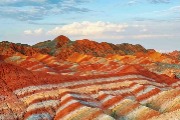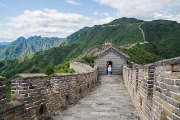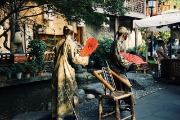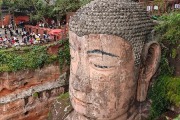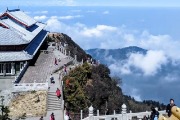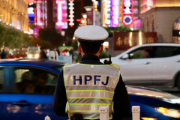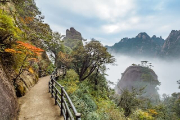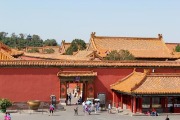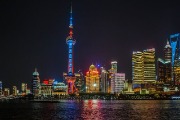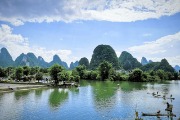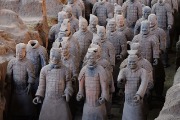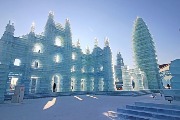Mount Emei in China
Mount Emei is known as the “Mountain of Buddhism” and the “Mountain of Taoism,” and it also has strong connections to Chinese martial arts.

Many Chinese people first hear about Mount Emei (Emei Shan Mountain 峨眉山) because of a famous Chinese martial arts novel, where there’s a martial arts sect called “Emei Sect.” In real life, Emei Kung Fu is actually one of the key schools of traditional Chinese martial arts. Besides that, Mount Emei Sichuan is also a sacred site for both Buddhism and Taoism. There are many temples and Buddhist statues here, drawing worshippers from all over the world every day.
A lot of travel articles about Mount Emei Shan only focus on the high-altitude areas, which can give a misleading impression of the place. In this article, we’ll give you a full picture of Mount Emei Sichuan, including the high, middle, and low areas. We’ll also include some frequently asked questions and ticket information to help you plan your trip.
Table of Contents
The High-Altitude Area of Mount Emei

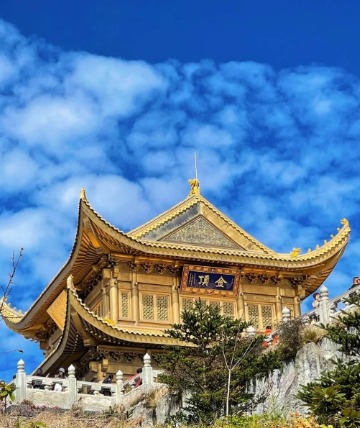
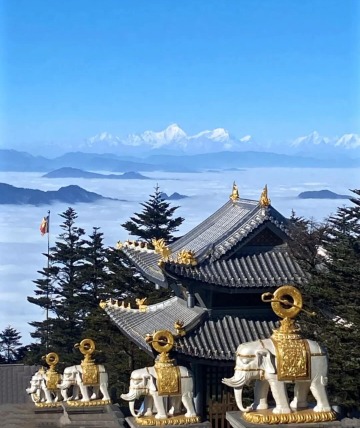
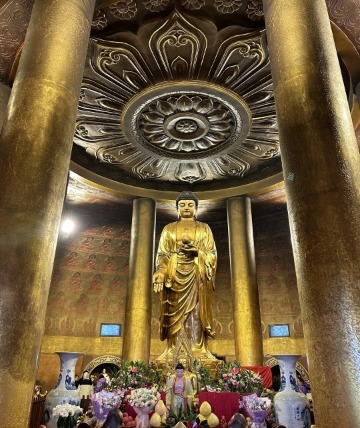
The Golden Summit (Jinding) (金顶)
The Golden Summit is the highest point of Mount Emei Shan, standing at 3,079.3 meters (about 10,100 feet). For many visitors, the first stop on their trip to Mount Emei is the Golden Summit, where they often take a bus directly to the top. From there, they gradually work their way down to explore the middle and lower areas.
At the Golden Summit, you’ll find many famous landmarks and buildings, including the massive statue of Samantabhadra (Puxian) Bodhisattva and the Huayan Temple. The statue of Samantabhadra is the largest and tallest of its kind in the world, standing at an impressive 48 meters, and it’s been listed as a UNESCO World Heritage site.
What does Samantabhadra represent? Samantabhadra is one of the Four Great Bodhisattvas in Chinese Buddhism, symbolizing wisdom and great compassion. He is also one of Buddha Shakyamuni’s two main assistants.
The statue at the Golden Summit is not just a representation of Mount Emei’s Buddhist culture; it also serves as a spiritual symbol for people’s inner aspirations. Every day, many monks from all over the world come to the Golden Summit to worship, and many tourists visit to see the sea of clouds or catch the stunning sunrise. The Golden Summit Temple also hosts various Buddhist lectures and meditation retreats to promote Buddhist culture.

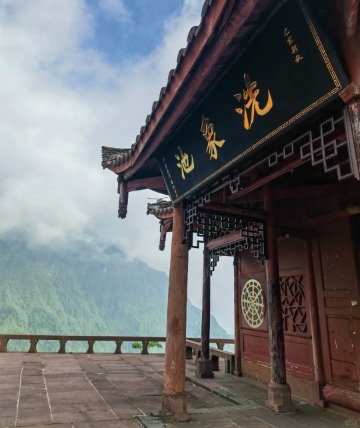
Elephant Bathing Pool (Xi Xiang Chi) (洗象池)
The Elephant Bathing Pool is located at an altitude of 2,070 meters (about 6,791 feet) on Mount Emei Sichuan. According to legend, Samantabhadra Bodhisattva once rode an elephant and bathed in this very pool, which is how it got its name.
At the site, you’ll find several temples, including the Maitreya Hall, the Mahavira Hall, and the Guanyin Hall, where you can explore and make wishes. The Elephant Bathing Pool is also a great spot for moon watching. At night, the view of the moon from here is truly magical and offers a unique experience.
The Middle-Altitude Area of Mount Emei
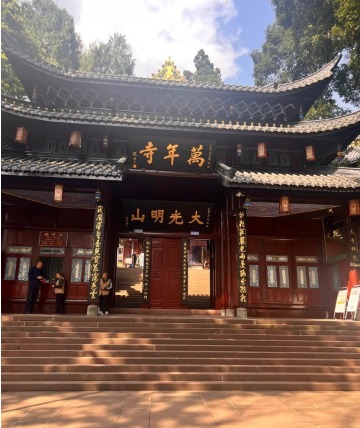
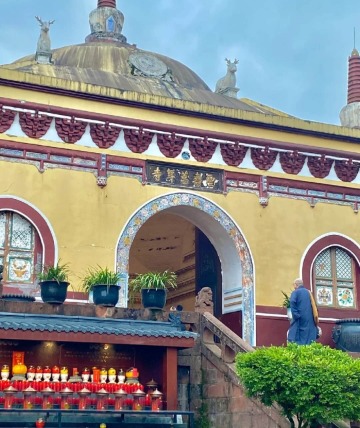
Wannian Temple (万年寺)
After visiting the Golden Summit in the high-altitude area, you can take a bus to Wannian Temple. The temple’s front hall houses a statue of the Buddha, while the middle and rear halls are dedicated to various Buddhist Bodhisattvas and historical figures.
Wannian Temple hosts many Buddhist events each year, such as Buddha’s birthday celebrations and dharma assemblies, attracting large numbers of pilgrims and tourists. You can also come here to pay respects, pray for peace and happiness, and immerse yourself in the strong religious atmosphere.
The temple is surrounded by beautiful scenery, with spacious courtyards and peaceful gardens. Strolling through the grounds, you’ll experience a sense of tranquility and harmony.
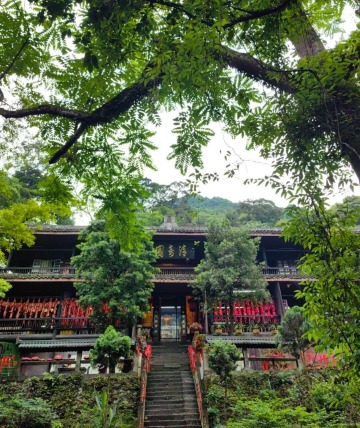

Qingyin Pavilion (清音阁)
After visiting Wannian Temple, if you head downhill, you’ll reach Qingyin Pavilion. Located halfway up Mount Emei Shan, this pavilion was built during the Ming Dynasty. It features several buildings, including the Mahavira Hall, Guanyin Pavilion, Samantabhadra Pavilion, and Manjushri Pavilion, and regularly hosts Buddhist events like water and land ceremonies and meditation retreats.
The area around Qingyin Pavilion is surrounded by mountains and water, home to various birds and wildlife. It’s a perfect spot for hiking and enjoying nature.
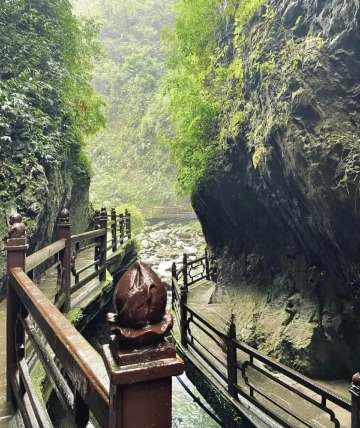
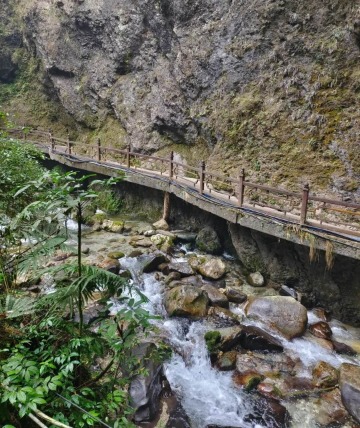
One Line Sky (一线天)
From Qingyin Pavilion to One Line Sky, the forest coverage is an impressive 95%, and the climate is cool, almost like a “natural air-conditioned room.” One Line Sky is a narrow crack in the mountain, splitting the towering cliffs in two. It creates a tight passageway with sheer vertical walls, giving visitors a thrilling sense of adventure as they walk through.
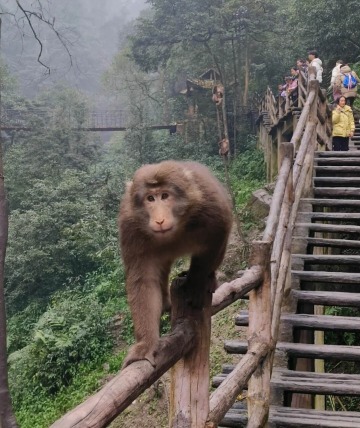
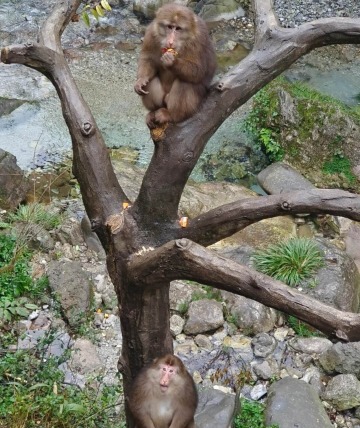

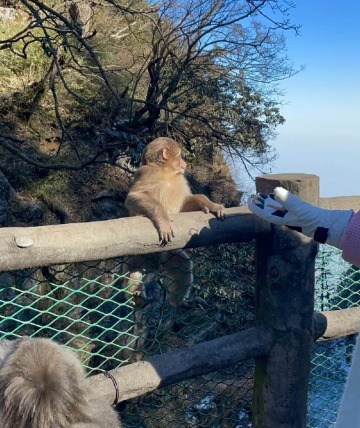
Mount Emei Ecological Monkey Area (峨眉山生态猴区)
The Emeishan Mountain Ecological Monkey Area is currently the largest natural wild monkey habitat in China, covering about 25 square kilometers. It’s home to a large number of wild monkeys, including over 300 rare species. The area is rich in different types of monkeys, such as the Tibetan macaque (also known as the Sichuan short-tail monkey or Big Green Monkey). Since they live on the famous Buddhist mountain of Mount Emei Sichuan, they’re often referred to as the “monk monkeys.”
The Ecological Monkey Area has walkways, pavilions, suspension bridges, and other facilities, making it easy for you to interact with the monkeys. You can feed them, observe their behavior, and even get up close for a more intimate experience. These monkeys are quite human-like, unafraid of people, and enjoy playing with visitors.
However, a word of caution: keep your backpack safe, as the monkeys may try to snatch valuable items inside. Also, don’t provoke them, as they might react aggressively. You might not know this, but the monkeys on Mount Emei Shan are quite famous in China for being wild, and some of them can even be aggressive toward tourists.
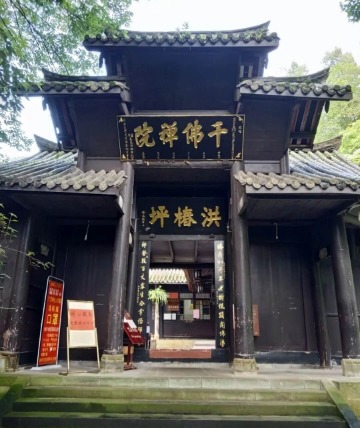
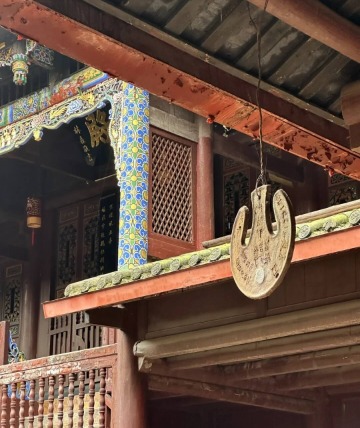
Hongchunping (洪椿坪)
After passing through the Ecological Monkey Area, you’ll reach Hongchunping, located at the base of Tianchi Peak on Emei Mountain. The temple is built into the mountainside, surrounded by lush trees and fresh, clean air. In the mornings, light rain often falls like mist over the courtyard, and the nearby forest is frequently shrouded in clouds, creating a truly unique and peaceful atmosphere.
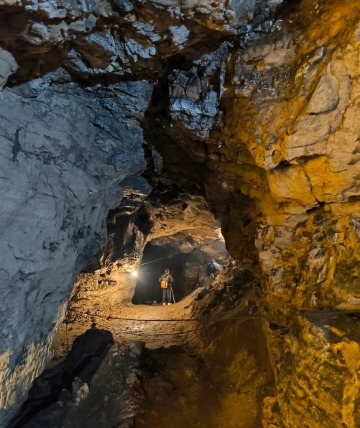
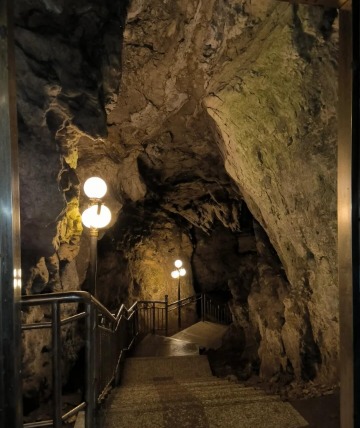
Jiulao Cave (九老洞)
Jiulao Cave, also known as Jiulao Immortal Cave, is steeped in mystery and legend. It’s said to be the gathering place for ancient Chinese immortals. Inside, the air is damp and eerie, and there’s only about 120 meters of passage where you can walk upright. The cave is a maze of winding tunnels, with more than 60 strange little chambers filled with fascinating geological wonders like stalactites, stalagmites, stone columns, and stone buds.
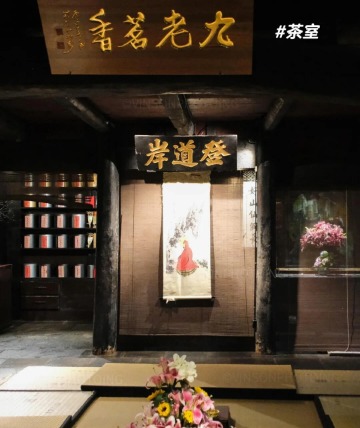

Xianfeng Temple (仙峰寺)
Xianfeng Temple is located right next to Jiulao Cave. The temple has three main halls: the Hall of the God of Wealth, the Mahavira Hall, and the Relic Hall. Additionally, Xianfeng Temple preserves a tea house built in the Qing Dynasty, which is one of the best-preserved Qing-era wooden structures on Mount Emei.
Xianfeng Temple also offers a variety of mountain experience activities, such as tea culture experiences, wellness practices, and Zen meditation, making it a perfect spot for visitors seeking peace of mind and spiritual tranquility.
Monkeys are often seen around the temple, and while they can be aggressive, the temple keeps three large guard dogs to protect visitors. Though the dogs are occasionally scratched by the monkeys, they are very friendly toward the tourists.
The Lower-Altitude Area of Mount Emei
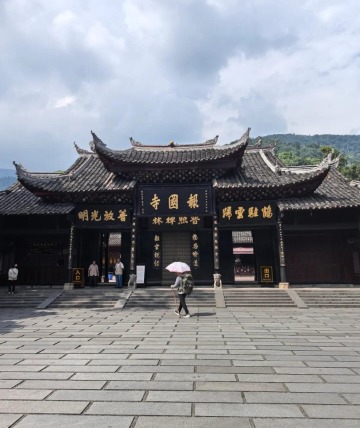
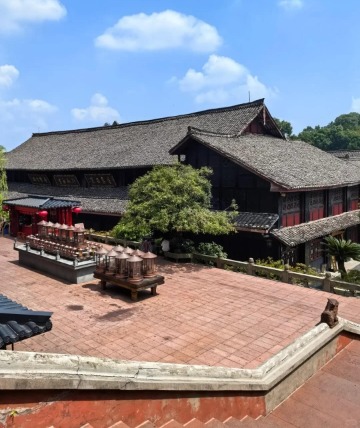
Baoguo Temple (报国寺)
After exploring the natural beauty of the middle-altitude area, you can head to the lower areas to visit some of Mount Emei’s most famous temples. Baoguo Temple, built during the Ming Dynasty, features the Mahavira Hall, Guanyin Pavilion, and Samantabhadra Hall, among other Buddhist halls. Here, you can participate in a variety of activities like pilgrimages, incense offerings, vegetarian meals, copying Buddhist scriptures, and making incense pouches. These activities not only allow you to experience the peaceful, meditative lifestyle of Buddhism but also help purify your mind and spirit. Afterward, you can enjoy a simple yet delicious vegetarian meal provided by the temple.
Baoguo Temple is open from 7:00 AM to 6:30 PM in summer, and from 7:30 AM to 6:00 PM in winter. The entrance fee is 8 RMB.
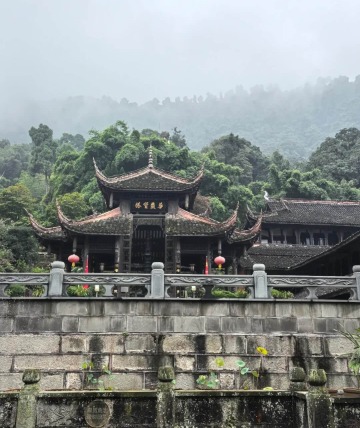
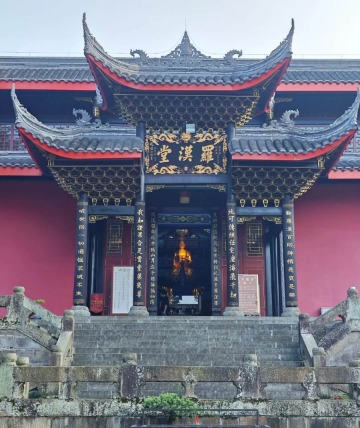
Fuhu Temple (伏虎寺)
Right next to Baoguo Temple is Fuhu Temple, an important center for Buddhist education, offering teachings to female monks. The temple has a strong Buddhist atmosphere and attracts visitors from all over the world, many of whom come here to practice yoga.
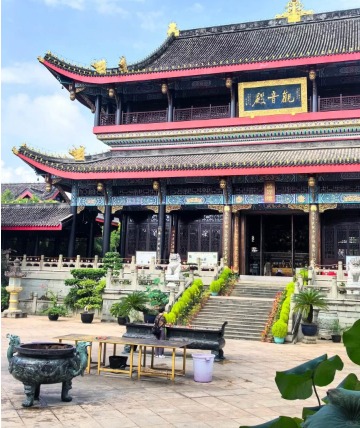
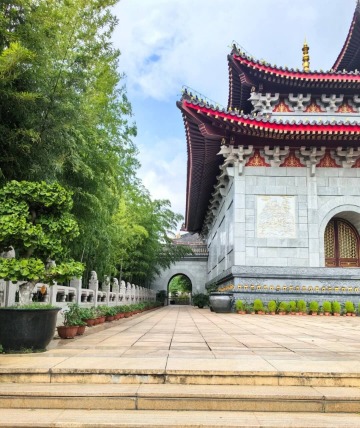
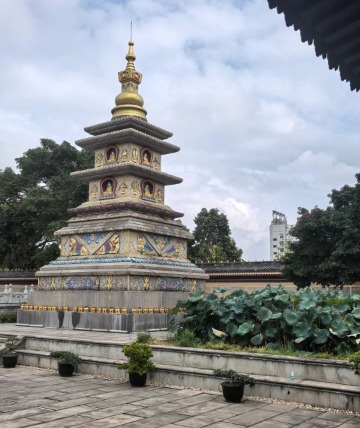
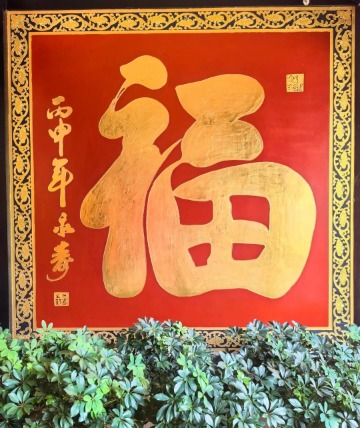
The Great Buddha Zen Monastery (大佛禅院)
The Great Buddha Zen Monastery is an important stop for many pilgrims visiting Emei Mountain. Its architecture blends styles from the Song, Ming, and Qing Dynasties. The main halls include the Hall of Great Compassion, the Maitreya Hall, the Medicine Buddha Hall, and the Manjushri Hall, each with its own unique architectural style and Buddhist cultural significance.
In addition, the monastery has a Sutra Pavilion that houses a collection of Buddhist scriptures, which visitors can explore and learn from.
Ways to Explore Mount Emei
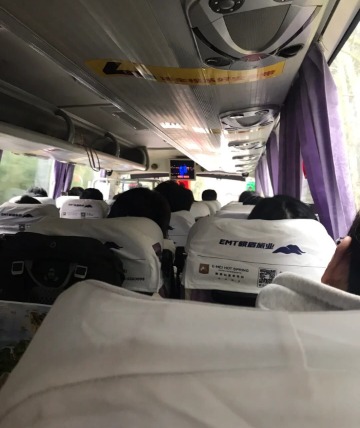
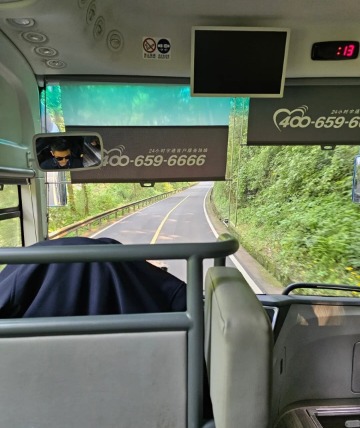
Tour Bus (大巴)
The tour buses on Emei Mountain take you to the main scenic spots, including Wannian Temple, Baolong Cave, Qingyin Pavilion, and other famous attractions, allowing you to see the highlights of the mountain in a short amount of time. The bus routes are designed to follow the terrain of Mount Emei, giving visitors the chance to enjoy the beauty of the mountain from different perspectives.
The staff on the tour buses are friendly and welcoming, always ready to share information about the history and culture of Emeishan Mountain and answer any questions you might have. Plus, the buses offer complimentary bottled water and snacks for a more comfortable ride.
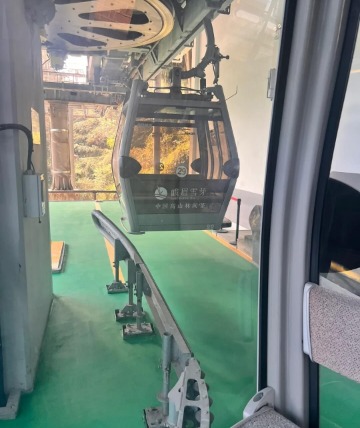
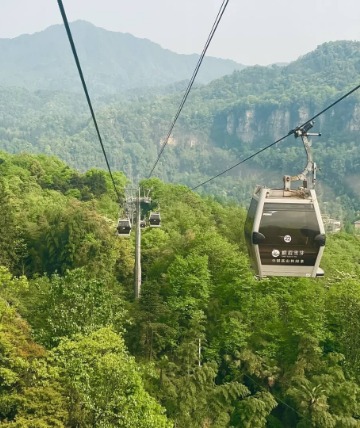
Cable Cars (索道)
Mount Emei has two types of cable cars: the reversible cable car and the circulating cable car. The reversible cable car, which can hold nearly 100 people, is the main choice for getting up the mountain quickly and efficiently. On the other hand, the circulating cable car, which only carries 6 people at a time, offers a more scenic ride with better views, though you’ll likely have to wait in a longer line to board. Both options have the same price, so it just depends on whether you want a faster or more scenic experience.
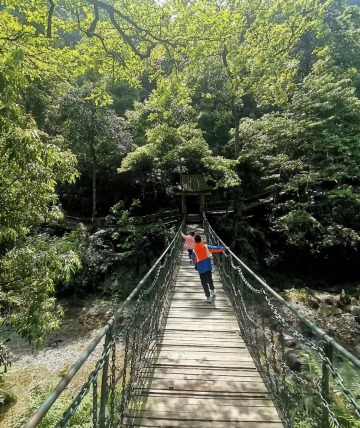
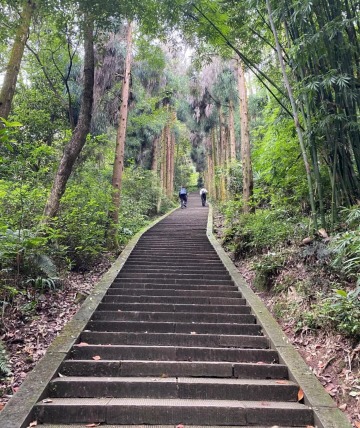
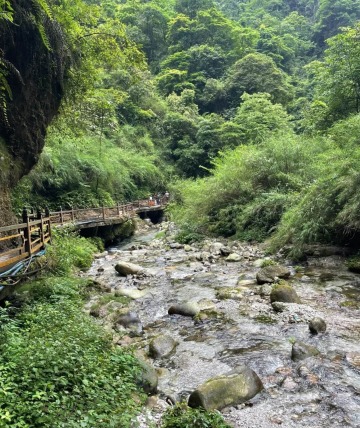
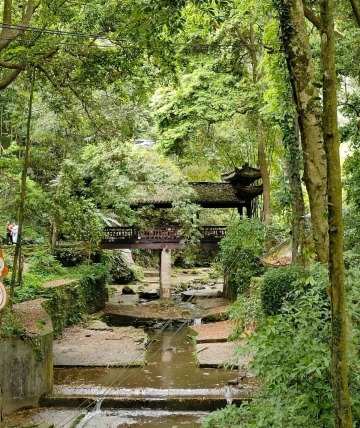
Hiking on Mount Emei (徒步)
Mount Emei offers a variety of hiking routes, so you can choose one that fits your fitness level and interests. The most classic route starts with taking a bus to Leidongping in the high-altitude area, then hiking to Jieyin Hall before taking a cable car up to the Golden Summit. After visiting the Golden Summit, you can slowly hike down to the middle-altitude area, exploring landmarks like Wannian Temple and Qingyin Pavilion, and finish by touring the temples in the lower-altitude area.
Emeishan Mountain is famous for its breathtaking natural landscapes, including unique peaks, bizarre rock formations, waterfalls, streams, and towering ancient trees. Hiking here isn’t just a great way to exercise your body and strengthen your willpower, it also allows you to relax, escape the hustle and bustle of city life, and enjoy the peaceful beauty of nature.
Activities on Emeishan Mountain
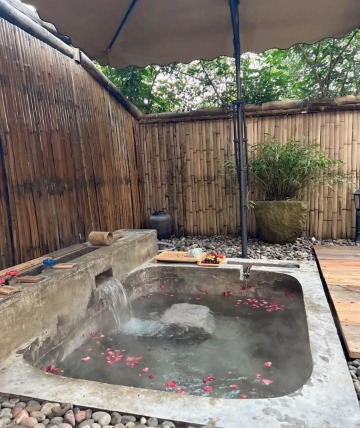
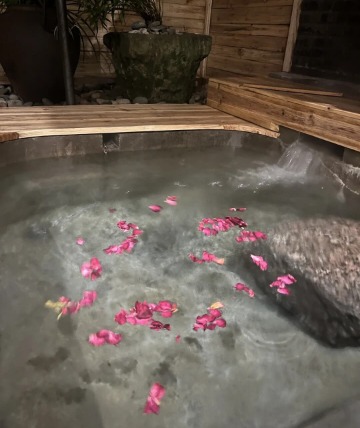
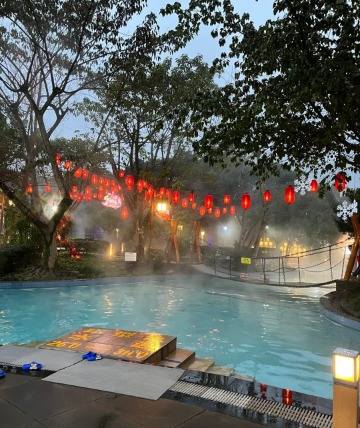
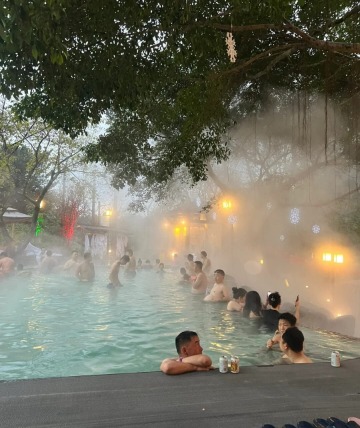
Hot Springs (温泉)
After touring Mount Emei, you can relax and unwind at one of the hot springs around the mountain. The hot springs are surrounded by lush greenery, with spacious facilities that include an indoor swimming pool and fish therapy area. Outdoors, there are various medicinal baths to enjoy. On weekends, you can also take part in family-friendly activities like tug-of-war. If you visit in the winter, soaking in the hot springs while watching the snow fall is a truly unforgettable experience.
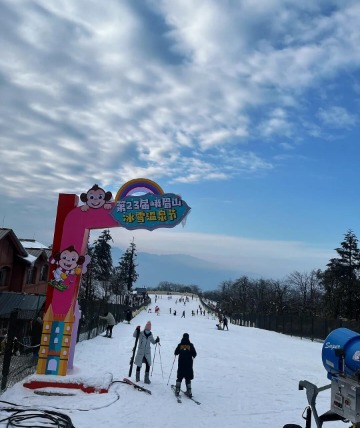
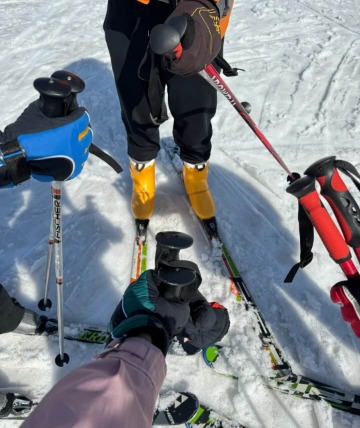
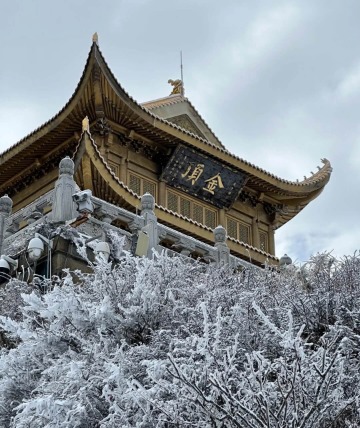
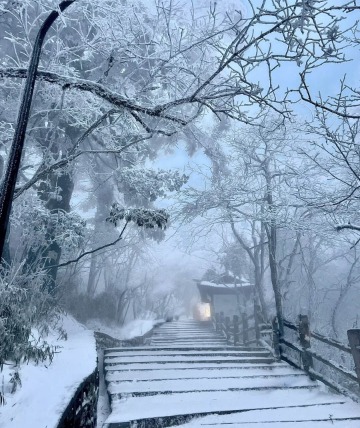
Skiing (滑雪)
The Mount Emei Ski Resort is located halfway up the mountain, covering an area of 15 acres. The snow season lasts from early October to the end of March, with snow depths reaching up to 1 meter. The resort offers a variety of skiing options, including a ski practice area, an ice and snow slope area (with both advanced and beginner trails), a snowball fight zone, and a snow sculpture area, making it suitable for skiers of all levels. The resort also provides professional ski equipment rentals, along with parking and dining facilities.
Accommodation on Emei Mountain
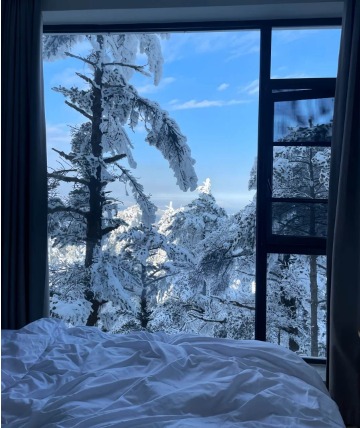
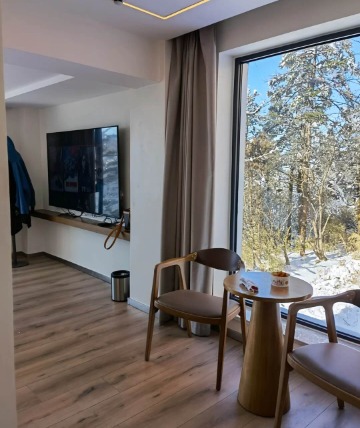
Mount Emei offers a variety of accommodation options at the Golden Summit, halfway up the mountain, and at the base. You can choose from temple stays, hot spring hotels, or modern hotels. If you want to experience the peaceful life of a monk and enjoy vegetarian meals, a temple stay is a great choice. If you’re feeling tired after hiking, you can relax in a hot spring hotel and soak in the warm waters, then enjoy a restful sleep.
FAQs About Mount Emei
1. Where is Mount Emei?
2. Why is Mount Emei important?
Mount Emei is one of China’s Four Sacred Buddhist Mountains. It’s the spiritual home of Samantabhadra Bodhisattva. The other three are Mount Wutai in Shanxi (home to Manjushri Bodhisattva), Mount Putuo in Zhejiang (home to Guanyin Bodhisattva), and Mount Jiuhua in Anhui (home to Kṣitigarbha Bodhisattva).
3. Can foreigners go to Mount Emei?
Yes, foreigners are welcome to visit and hike Mount Emei.
4. How long does it take to climb Mount Emei?
If you’re hiking from the base to the top, it’s about a 50-kilometer journey. Fit hikers usually take at least 15 hours, but some may need up to 22 hours to complete it. Most visitors opt to take a bus to the top and then hike down, which saves a lot of energy and time.
5. How many days do you need in Emeishan?
You should plan to spend 2-3 days on Mount Emei. If you’re short on time, you can squeeze in visits to some major spots in one day, but it will be a bit rushed.
How to Get to Mount Emei
You can take a train from Chengdu Railway Station or Chengdu East Station directly to Emei Mountain Station. From there, take a free shuttle bus (about 15 minutes) to the Huangwan Visitor Center, where you can transfer to a sightseeing bus that will take you up the mountain.
Hours & Fees
Hours
Summer & Fall (May 1st – October 31st): 6:00 AM – 6:30 PM
Winter & Spring (November 1st – April 30th): 7:00 AM – 5:30 PM
Please note, night-time visits to Mount Emei are no longer allowed.
Time Required
1-3 days
Fees
Ticket Prices:
Peak Season (January 1st – December 31st): 185 CNY (about 25 USD) per person
Off-Season (December 16th – January 15th): 110 CNY (about 15 USD) per person
Golden Summit Cable Car:
Peak Season: 65 CNY (about 9 USD) up, 55 CNY (about 7.50 USD) down
Off-Season: 30 CNY (about 4 USD) up, 20 CNY (about 3 USD) down
Wannian Cable Car:
Peak Season: 65 CNY (about 9 USD) up, 45 CNY (about 6 USD) down
Off-Season: 30 CNY (about 4 USD) up, 20 CNY (about 3 USD) down
Tourist Bus Tickets:
Full mountain round-trip: 90 CNY (about 12 USD) per person
Half-mountain round-trip: 40 CNY (about 5.50 USD) per person
Temple Tickets:
10 CNY (about 1.50 USD) per person
Skiing:
80 CNY (about 11 USD) per person per hour
Practical Tips
If you’re planning to visit Emei Shan Mountain China during a Chinese holiday, book your accommodation early. Hotels fill up fast, and you might struggle to find a place if you wait too long.
If you have knee problems, don’t forget to bring knee pads. Otherwise, you might find yourself in too much pain to finish the hike.
Always check the weather forecast. It’s best to avoid rainy days because hiking in the rain can be exhausting. If you do go, make sure to pack a raincoat and shoe covers.
Keep your gear light and just bring a backpack. You can leave your suitcase at the visitor center.
Even in the summer, bring a jacket. The temperature can drop significantly on the mountain, and it can get really chilly!
If you’re hiking, don’t pack too much. Just bring some basic water and snacks. If you run out, there are places on the mountain where you can buy more.
Don’t try to get too close to the monkeys on Mount Emei. Some of them can be aggressive and might scratch you or snatch your belongings.

